Discover 20 hidden attractions, cool sights, and unusual things to do in Duisburg (Germany). Don't miss out on these must-see attractions: Zoo Duisburg, Landschaftspark Duisburg-Nord, and Museum Küppersmühle. Also, be sure to include Museum der Deutschen Binnenschifffahrt in your itinerary.
Below, you can find the list of the most amazing places you should visit in Duisburg (North Rhine-Westphalia).
Table of Contents
Zoo Duisburg
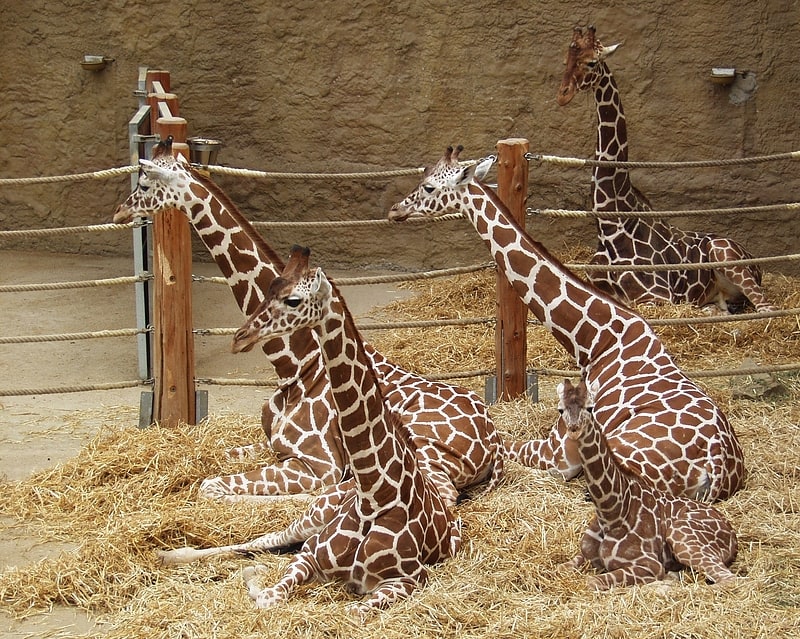
Zoological garden in Duisburg, Germany. The Duisburg Zoo, founded on 12 May 1934, is one of the largest zoological gardens in Germany. It is especially well known for its dolphinarium and, since 1994, for breeding koalas.
Far less well known are the breeding successes in other areas, for example, with fossas (carnivorous mammals from Madagascar) and red river hogs.
The zoo is located in the northern part of the Duisburg urban forest on the border with Mülheim on the Ruhr. Federal highway A 3 divides the zoo into western and an eastern parts, which are joined by a leafy country bridge. The highway is scarcely noticeable to the visitors.[1]
Address: Muelheimer Str. 273, 47058 Duisburg (Duisburg Mitte)
Landschaftspark Duisburg-Nord
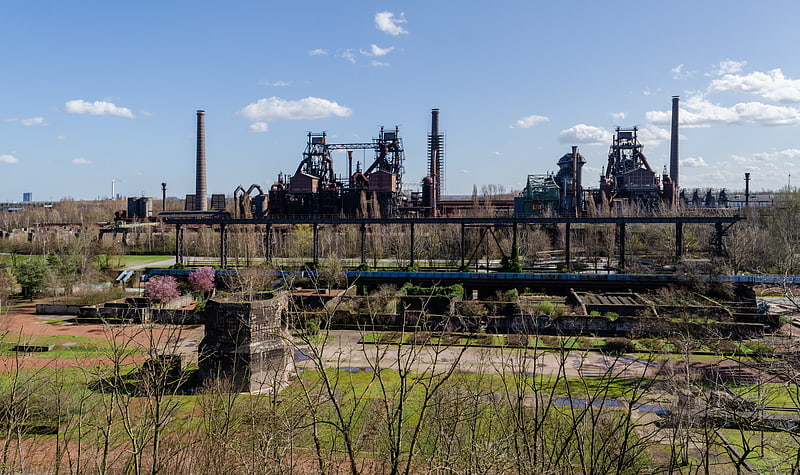
Outdoor sport park at ex-industrial site. Landschaftspark is a public park located in Duisburg-Meiderich, Germany. It was designed in 1991 by Latz + Partner, with the intention that it work to heal and understand the industrial past, rather than trying to reject it. The park closely associates itself with the past use of the site: a coal and steel production plant and the agricultural land it had been prior to the mid 19th century.[2]
Address: Emscherstr. 71, 47137 Duisburg (Meiderich-Beeck)
Museum Küppersmühle
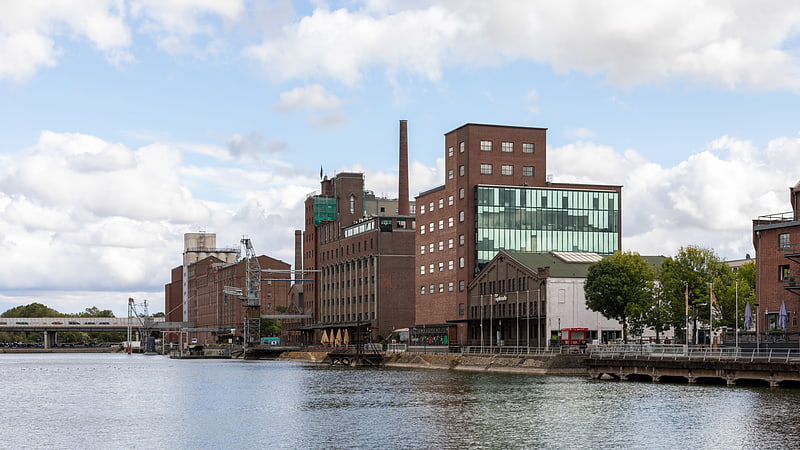
Modern and contemporary German art museum. Museum Küppersmühle is a Centre for Modern and Contemporary Art based Duisburg's Inner Harbour. It houses the Ströher Collection. It is part of the Duisburg: Town and Harbour section of the Ruhr Industrial Heritage Trail.[3]
Address: Philosophenweg 55, 47051 Duisburg (Duisburg Mitte)
Museum der Deutschen Binnenschifffahrt
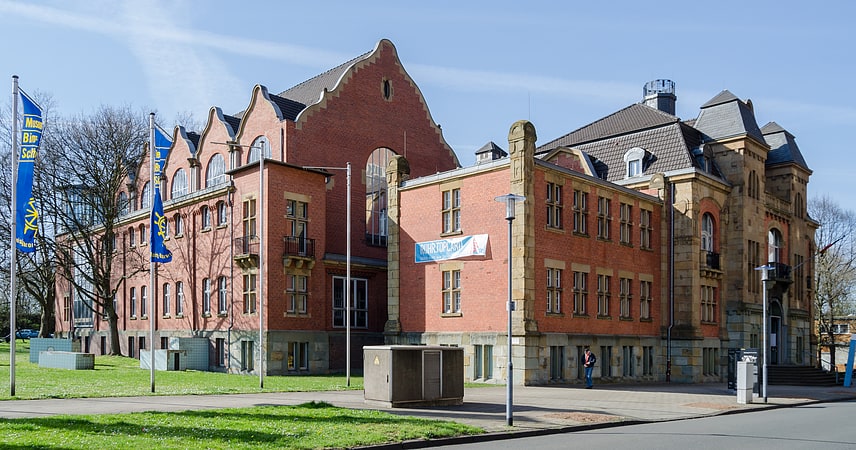
Museum in Duisburg, Germany. The German Inland Waterways Museum is located in Ruhrort, Duisburg at the nucleus of Duisburg-Ruhrorter ports which today make up the largest European inland harbour complex.
The museum was founded in 1974 with purchase of the museum ship Oscar Huber. In 1998 the museum was moved from the old town hall into the city's former indoor swimming facility, an Art Nouveau landmark which had been built in 1910, closed in 1986, and declared a protected historic site in 1988. The move allowed the museum the space to exhibit complete ships, as well as spurring redevelopment in the harbor area. The building conversion was designed by Architektur Fabrik Aachen (afa) and an American artist, Ron Bernstein, and made very little change to the building exterior while expanding the inner spaces to accommodate the exhibits. For example, a full-size sailing ship now occupies the former men's pool, while the second-story women's pool now houses a reconstructed barge.[4]
Address: Apostelstraße 84, 47119 Duisburg (Meiderich-Beeck)
Duisburg-Hochfeld Railway Bridge

Also known as: Duisburg-Hochfelder Eisenbahnbrücke
Truss bridge in Duisburg, Germany. The Duisburg–Hochfeld railway bridge spans the Rhine in the German city of Duisburg on the Duisburg-Ruhrort–Mönchengladbach line. The first bridge was built by the Rhenish Railway Company and put into operation at the end of 1873. It was replaced by a new bridge in 1927, which was badly damaged during the Second World War, but rebuilt and is still serves rail traffic between the Ruhr region and Aachen.[5]
Rheinorange
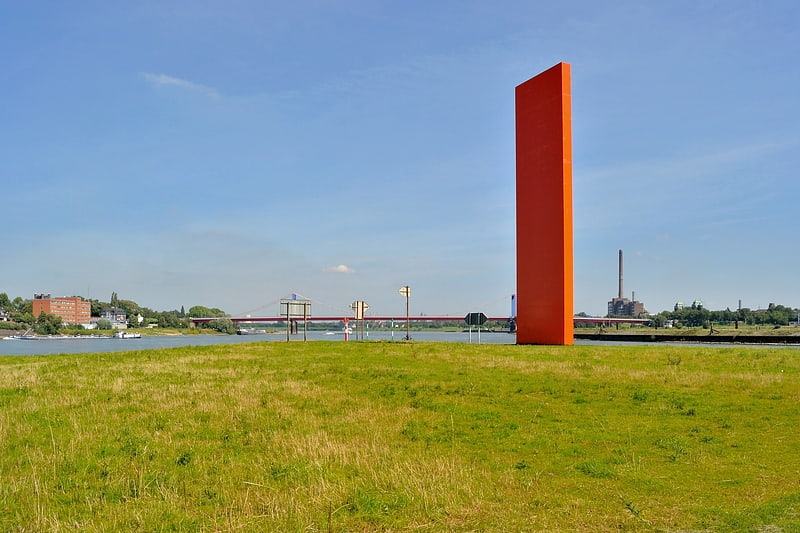
Sculpture by Lutz Fritsch. Rheinorange is a sculpture erected in 1992 in Duisburg-Neuenkamp, Germany. It is located at the point where the Ruhr flows into the Rhine at 'Rheinkilometer 780', i.e. 780 km from the source of the Rhine. It was constructed from steel by the sculptor Lutz Fritsch from Köln.
It is 25 m tall, 7 m wide and 1 m thick, and weighs 83 tonnes. The cost was over 400.000 DM, which was donated by the Niederrhein IHK (chamber of commerce) after a fund-raising initiative by the young entrepreneurs members. The name Rheinorange is actually a play on words. It sounds like Reinorange (pure orange) which is RAL 2004 in the RAL color standard.
The sculpture is intended to form a landmark. The mouth of the river, the largest inland harbour in Europe, the most important steel district in Europe, a base for technology with a future, the Lehmbruck-Museum as an important gallery for modern sculpture in Europe, are all intended to be connected with each other in representing aspects of the economic and cultural life of Duisburg.
The Rhine Orange is a feature on the Ruhr Industrial Heritage Trail.[6]
Brücke der Solidarität
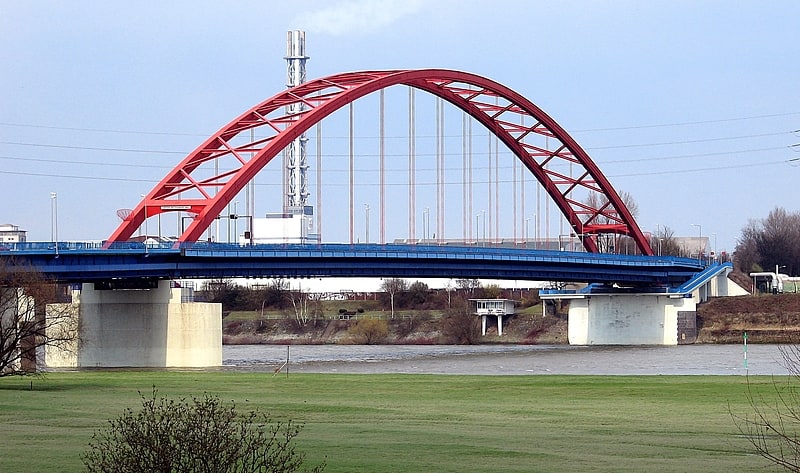
Tied-arch bridge in Duisburg, Germany. The Bridge of Solidarity is a bridge across the Rhine between the boroughs of Rheinhausen and Hochfeld in the city of Duisburg.[7]
Address: Moerser Str. / L 237, 47228 Duisburg (Duisburg Mitte)
Abtei Hamborn
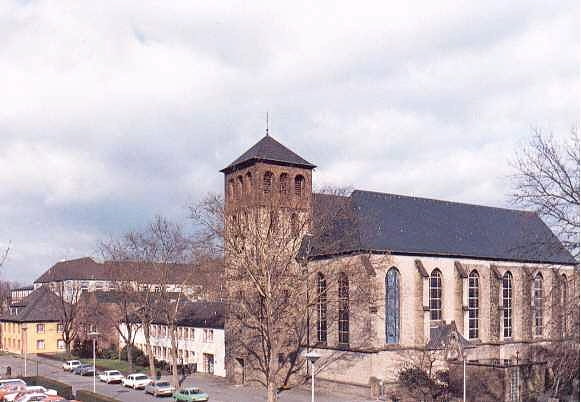
Monastery in Duisburg, Germany. Hamborn Abbey is a Premonstratensian monastery in the Alt-Hamborn district of Duisburg, Germany. The abbey is physically located in the diocese of Essen, although not formally part of it.[8]
MSV-Arena
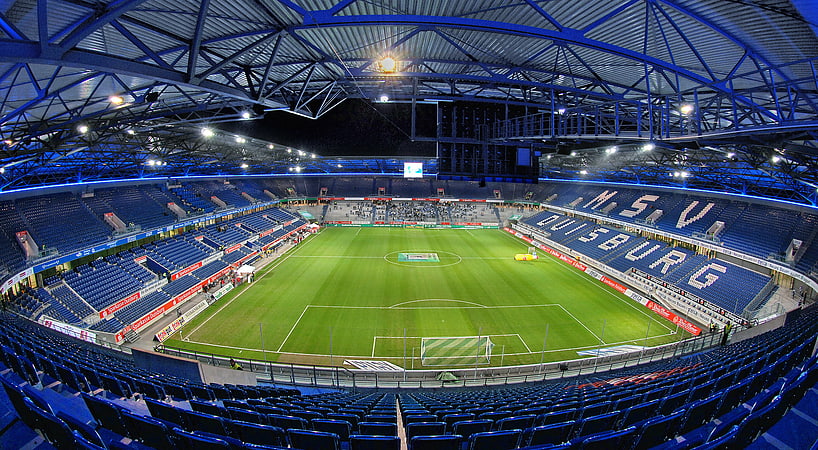
Also known as: Schauinsland-Reisen-Arena
Arena in Duisburg, Germany. MSV-Arena, currently known for sponsorship purposes as the Schauinsland-Reisen-Arena, is a football stadium in Duisburg, North Rhine-Westphalia, Germany, built in 2004. The stadium is the home of MSV Duisburg and holds 31,500 people. It was built on the site of the old Wedaustadion. The stadium was the venue of the 2005 World Games.[9]
Address: Margaretenstraße 5-7, 47055 Duisburg (Duisburg Mitte)
Die Säule
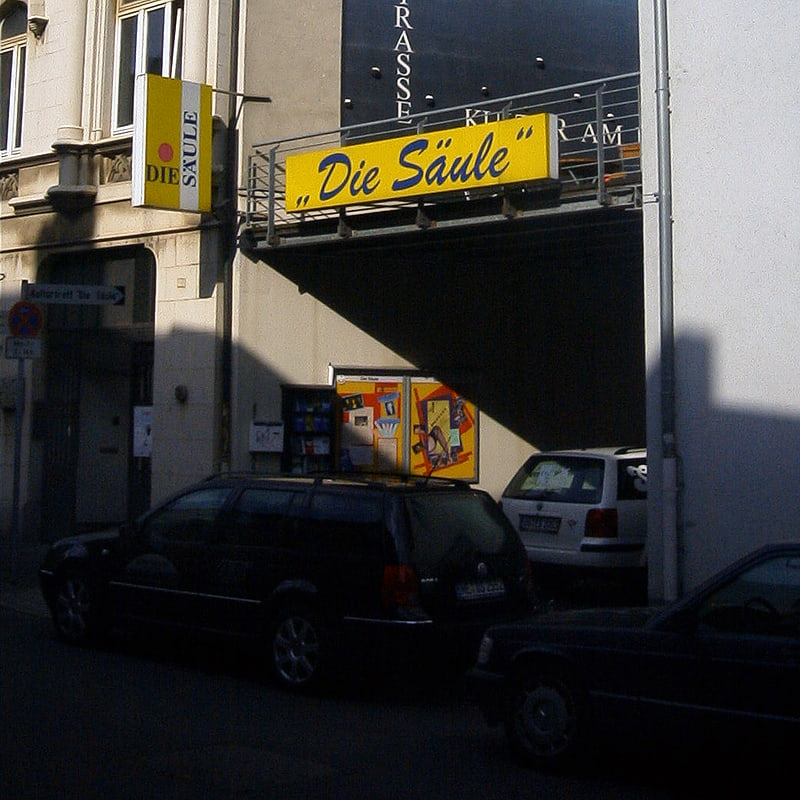
Die Säule is a theatre in Duisburg, North Rhine-Westphalia, Germany.[10]
Lehmbruck Museum
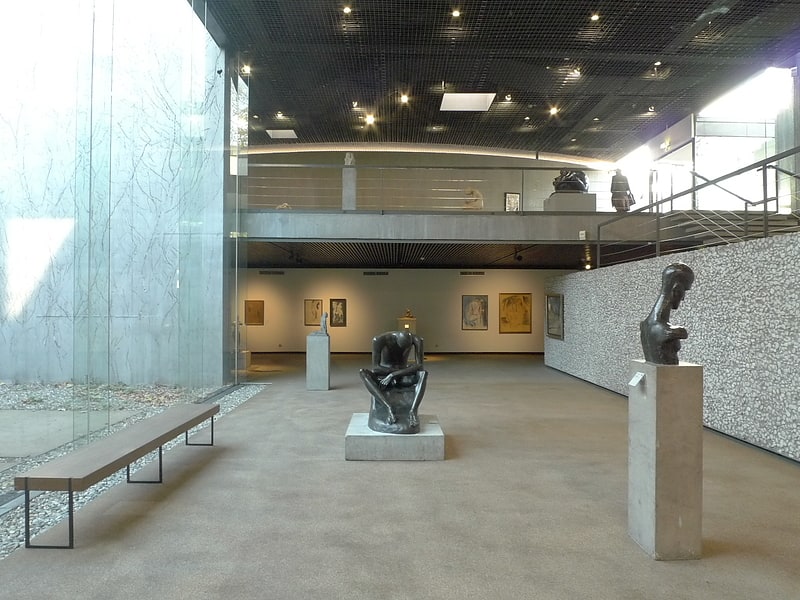
Also known as: Lehmbruck-Museum
Venue for modern international sculpture. The Stiftung Wilhelm Lehmbruck Museum - Center for International Sculpture is a museum in Duisburg, Germany.
Sculptures by Wilhelm Lehmbruck, after whom the museum is named, make up a large part of its collection. However, the museum has a substantial number of works by other 20th-century sculptors, including Ernst Barlach, Käthe Kollwitz, Ludwig Kasper, Hermann Blumenthal, Alexander Archipenko, Raymond Duchamp-Villon, Henri Laurens, Jacques Lipchitz, Alexander Rodtschenko, Laszlo Péri, Naum Gabo, Antoine Pevsner, Pablo Picasso, Salvador Dalí and Max Ernst. This is complemented by a considerable number of paintings by 19th- and 20th-century German artists. The museum circulates its substantial collection by re-installing works on an annual basis.[11]
Address: Düsseldorfer Str. 51, 47051 Duisburg (Duisburg Mitte)
Botanischer Garten Duisburg-Hamborn
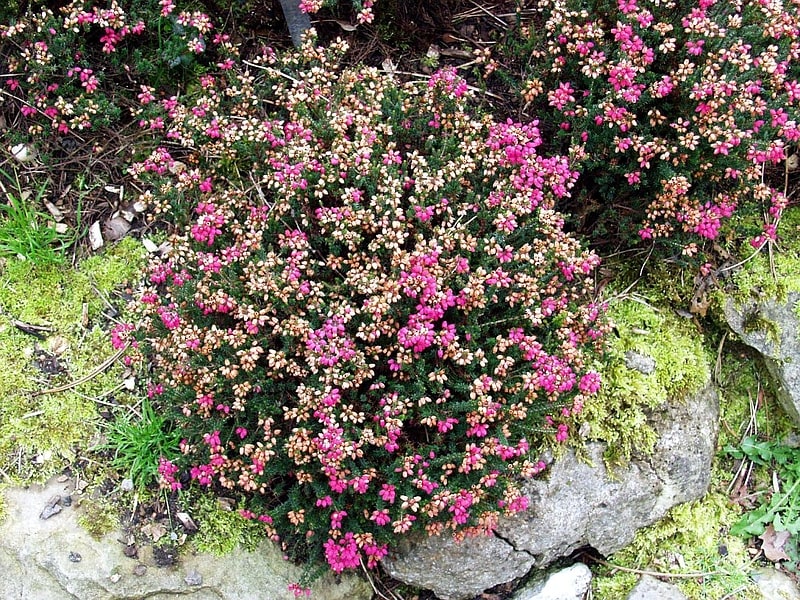
Botanical garden in Duisburg, Germany. The Botanischer Garten Duisburg-Hamborn, also known as the Botanischer Garten Duisburg or the Botanischer Garten Hamborn, is a municipal botanical garden and aquarium located at Fürst-Pückler-Straße 18, Duisburg, North Rhine-Westphalia, Germany. It is open daily, and should not be confused with the Botanischer Garten Kaiserberg, another botanical garden in Duisburg.
The garden hosts about 1,000 species outdoors and in greenhouses. Major features of the garden include a landscape park, rhododendrons, fuchsia and primula collections, aromatic and medicinal plants, and ferns. The garden has also a lily pond, tropical greenhouse, subtropical greenhouse, and greenhouse containing about 800 cacti and succulents, as well as an aquarium.
According to local newspaper WAZ in March 2010 it had been on a list of community facilities together with public baths, that would be closed subsequently, since funding was no longer lawful as of Art. 81 in German Haushaltsrecht. The mayoral council of Duisburg decided against these plans – though without having found a proper way of funding that would and could find approval by superior Bezirksregierung Düsseldorf, which controls the city's funds.[12]
Address: Fürst-Pückler-Straße 18, Duisburg (Hamborn)
Theater am Marientor
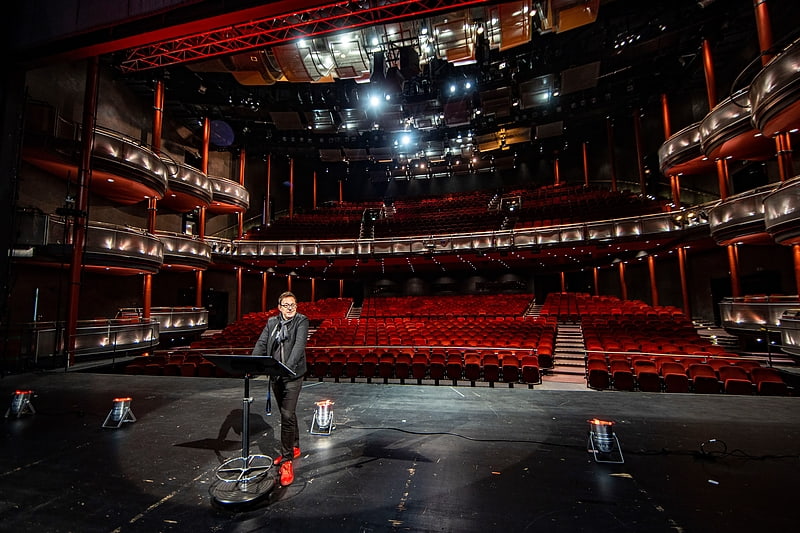
Theatre in Duisburg, Germany. Theater am Marientor is a theatre in Duisburg, North Rhine-Westphalia, Germany.[13]
Address: Plessingstr. 20, 47051 Duisburg (Duisburg Mitte)
Schwanentorbrücke

Vertical-lift bridge in Duisburg, Germany. The Schwanentorbrücke is a vertical-lift bridge in Duisburg, North Rhine-Westphalia, Germany, that crosses the Duisburg Inner Harbour. The bridge can be vertically raised to allow cargo ships to access the inner city, and lowered to allow cars, trains and pedestrians to cross. The bridge is named after the Schwanenturm that protected the city walls in the 13th and 14th centuries.[14]
Duisburg Inner Harbour
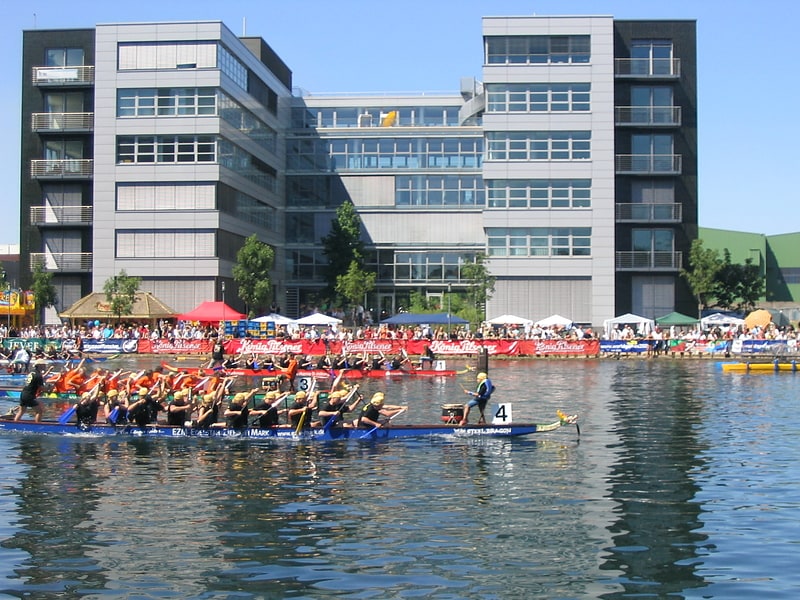
Also known as: Innenhafen Duisburg
Old harbor with restaurants and park areas. The Innenhafen in Duisburg, Germany, is connected to the Rhine River, encompasses an area of 89ha. For over a hundred years during the high point of the Industrial Revolution, it was the central harbour and trading point of the town. Since the mid 1960s, the importance of the harbour declined and it lay in a disused condition for 20 years, before plans for renovation were drawn up. This former industrial area has been fundamentally transformed, a process which started as a part of the International Building Exhibition Emscher Park which ran from 1989 until 1999.
The basis for this model of development in the Ruhr district was delivered in 1994 by the British architect Norman Foster. Since then, the Inner Harbor has transformed itself into a district combining employment, housing, culture and water-based leisure activities. Today, the Inner Harbour is both industrial heritage and a main stop on the Route der Industriekultur.[15]
Botanischer Garten Kaiserberg

Garden in Duisburg, Germany. The Botanischer Garten Kaiserberg is a botanical garden located at Schweizer Straße 24, Duisburg, North Rhine-Westphalia, Germany. The garden was established in 1890 and primarily cultivates native plants, but also includes exotic flora such as Araucaria, Ginkgo biloba, Sequoiadendron. It is open daily without charge, and should not be confused with the Botanischer Garten Duisburg-Hamborn, another botanical garden in Duisburg.[16]
Address: Schweizer Str. 24, Duisburg (Duisburg Mitte)
DİTİB Merkez Mosque
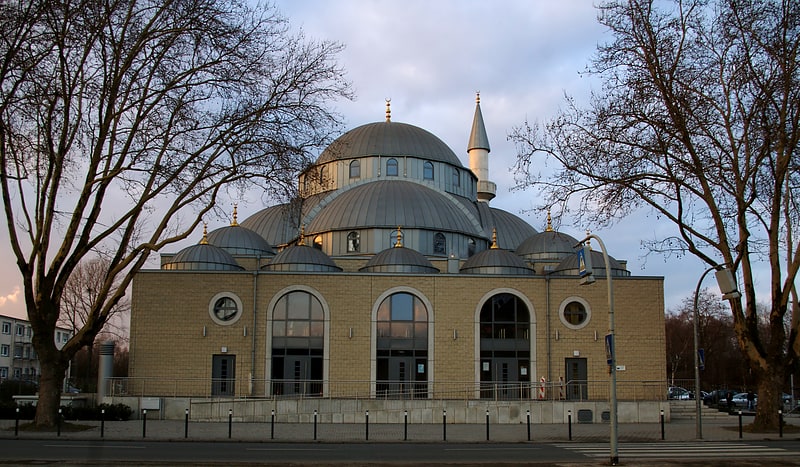
The DITIB Merkez Mosque in Duisburg of the Turkish-Islamic Union of the Institution for Religion is an Islamic place of worship in the district of Duisburg-Marxloh.
Address: Warbruckstr. 51, Duisburg (Hamborn)
Tiger and Turtle – Magic Mountain
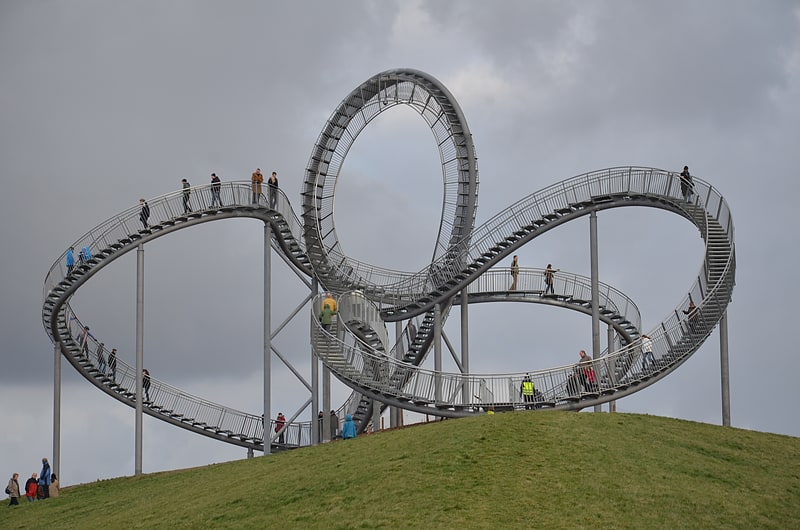
Art. Tiger and Turtle – Magic Mountain is an art installation and landmark in Angerpark, Duisburg, Germany, built in 2011. It was designed by Ulrich Genth and Heike Mutter. It resembles a roller coaster, but it is a walkway with stairs. Its vertical loop continues the walkway and stairs, but it is unwalkable and is blocked off. In 2013, Tiger and Turtle – Magic Mountain was ranked as #6 on HuffPost's list of Most Extreme Staircases.[17]
Address: Ehinger Straße 117, Duisburg (Duisburg Süd)
Speicher Allgemeine
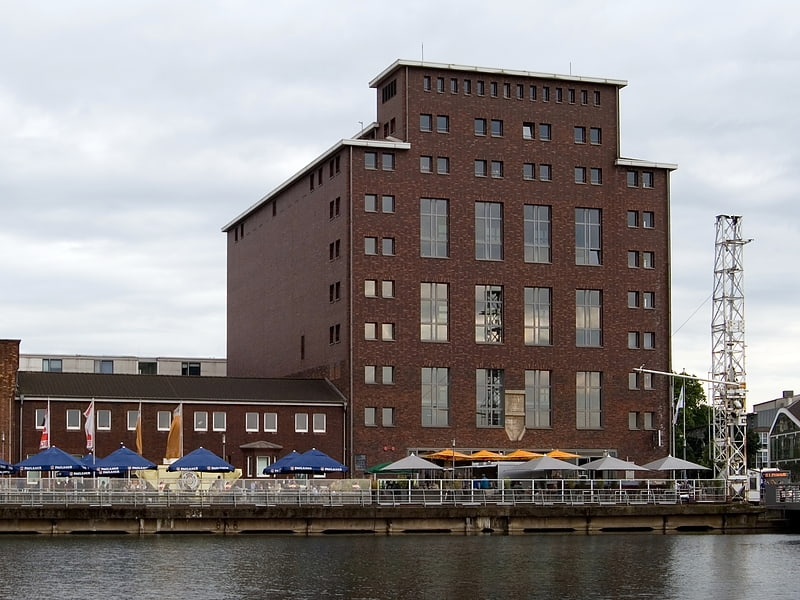
Historical landmark in Duisburg, Germany. The Allgemeine Grainstore is a former granary now used for office space and parking facilities. It is located at 17 Philosophenweg, Duisburg Inner Harbour. The warehouse was built for the "Allgemeine Speditionsgesellschaft". When it was built in 1936 it transformed the technology of concrete silo construction technology.
It stands prominently on its own near the Holzhafen. The building was rebuilt in 1999 to designs of the architects Bahl and Partners. The building was dismantled down to its foundations. The façade was reconstructed out of clinker, glass and metal to preserve its historic appearance. Nevertheless it has a highly efficient building shell. It houses office space which can accommodate 200 workers.[18]
Theater Duisburg
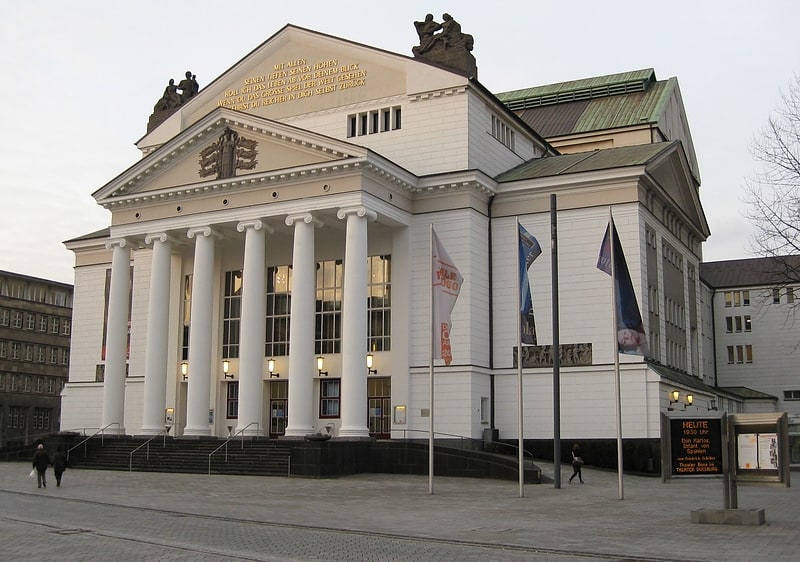
Theatre in Duisburg, Germany. The Theater Duisburg is located in Duisburg, Germany and is one of two opera houses where performances are given by the Deutsche Oper am Rhein. The other is the Opernhaus Düsseldorf in Düsseldorf.
The original theatre was built in 1912, destroyed during the Second World War, and rebuilt in 1950. Due to the refurbishment of the Düsseldorf opera house (built in 1956), the 50th Anniversary celebration of the company's resumption after the war took place on 28 September 2006 in Duisburg with a performance of Richard Strauss' Elektra, the company's premiere of which was presented 29 September 1956.[19]
Address: Neckarstr. 1, 47051 Duisburg (Duisburg Mitte)